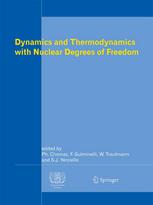

Most ebook files are in PDF format, so you can easily read them using various software such as Foxit Reader or directly on the Google Chrome browser.
Some ebook files are released by publishers in other formats such as .awz, .mobi, .epub, .fb2, etc. You may need to install specific software to read these formats on mobile/PC, such as Calibre.
Please read the tutorial at this link: https://ebookbell.com/faq
We offer FREE conversion to the popular formats you request; however, this may take some time. Therefore, right after payment, please email us, and we will try to provide the service as quickly as possible.
For some exceptional file formats or broken links (if any), please refrain from opening any disputes. Instead, email us first, and we will try to assist within a maximum of 6 hours.
EbookBell Team

4.0
16 reviewsThe study of nuclear reaction dynamics and thermodynamics with nuclear degrees of freedom has progressed dramatically in the past 20 years, from inclusive charge distributions to exclusive isotopically resolved fragment observables and from schematic phenomenological break-up models to sophisticated quantum many-body transport theories. A coherent and quantitative understanding of reaction mechanisms and of the underlying nuclear matter equation of state is emerging from the analysis of experimental data and from the theoretical modeling of heavy ion reactions. In addition, the accumulated evidence for phenomena related to the liquid-gas phase transition of nuclear matter has triggered interdisciplinary activities and the transfer of useful methods. In the near future, the availability of radioactive beam facilities is expected to provide unique opportunities for extending our knowledge of the dynamic properties and the nuclear phase diagram towards exotic nuclear systems with important astrophysical implications.
The present volume is the outcome of a community-wide review of the field of dynamics and thermodynamics with nuclear degrees of freedom which has been initiated two years ago. The achievements and the outstanding open questions are presented in 26 articles of together 61 authors and collected in six topical sections. All authors are internationally recognized experts in their fields.